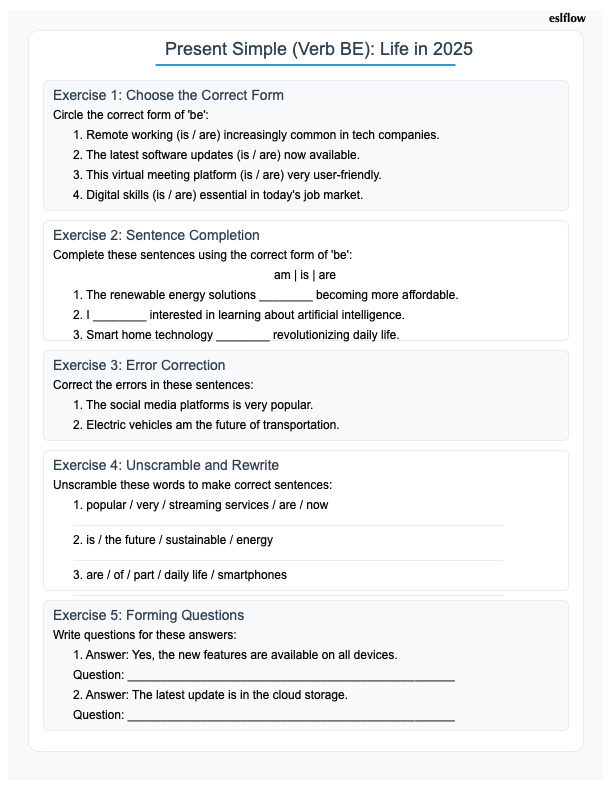Note: the complete set of exercises with answers can be downloaded at the end of the post. In future, I will be integrating grammar exercises into all the lessons.
Here is a list of today’s exercises:
Business in 2025: Future Tense
Cross-Cultural Communication: Future Tense
Medical Customer Service: Imperatives
Cybersecurity Best Practices: Modal Verbs
Modern Office Teamwork: Present Continuous
Understanding Brain Functions: Present Simple (Be)
Understanding Brain Functions: Present Simple (Do)
Life in 2025: Present Simple (Be)
Life in 2025: Present Simple (Do)
Applying for Medical Research Jobs: Present Simple (Do)
Grammar instruction often stumbles on a fundamental challenge: students need to master complex linguistic patterns while maintaining enough interest to actually practice them. Conventional textbooks often failed to engage students with their generic, one-size-fits-all approach, prioritizing publishers' profits over classroom effectiveness. In my own teaching, this led to difficult choices. While I sometimes de-emphasized grammar when it wasn't central to course objectives, I also noticed something striking: students became more engaged when presented with brief, focused exercises, especially ones that connected to their interests or career aspirations.
The challenge was always resources and time. Creating personalized, targeted grammar content for different groups of learners seemed impossible given the constraints. Even major publishers couldn't justify developing such specialized materials. But artificial intelligence has changed this equation dramatically. Now we can instantly generate varied, engaging grammar exercises that are adapted to individual interests and learning needs.
Present Simple: Verbs Do and Be
Life in 2025
Life in 2025: In these first exercises, we focus on "Life in 2025". By focusing on technology-related themes, the content connects to what students actually care about and what they'll need in their careers. It's a refreshing change from textbooks that recycle the same old scenarios, making grammar practice feel relevant and useful.
The worksheets take students through a natural learning sequence. They start by choosing correct forms, move on to filling in blanks, then tackle error correction to show they understand the rules. Next comes unscrambling sentences, and finally creating their own questions. Each step builds on the last, letting students gradually take control of the grammar.
Applying for Medical Research Jobs
Since I started teaching pharmacy and medical science students, I have been increasingly customizing the course content. In my classes, I often give students a choice of which activities to do (critical thinking, vocabulary/picture matching, listening, etc.). Usually, they skip grammar. But I was pleasantly surprised recently by how many students were quite attracted to grammar exercises customized to their careers. The content of these exercises focuses on applying for medical research jobs. They work on two levels - students learn correct grammar while picking up the exact language they'll need for job hunting and work. Instead of seeing grammar as just rules to memorize, students recognize it as a practical tool they'll use in their careers.
Future Tense
Cross-Cultural Communication (in a business context)
Modern grammar exercises are more effective when they embed practice within real-world contexts that matter to students. Instead of generic examples, learners work with language about remote work, technology implementation, and cross-cultural communication - the exact scenarios they'll encounter in their careers. The content covers emerging fields like AI, renewable energy, and virtual conferences, so students build relevant vocabulary while mastering grammar. This approach also weaves in cultural awareness training, preparing learners for the realities of today's globalized workplace.
Business in 2025
Imperatives
Imperatives for Medical Customer Service
Imperatives for Medical Customer Service reflects workplace reality - it's exactly what medical staff do all day long. They give instructions at reception, explain medication routines, provide follow-up care directions, and guide patients through procedures. The grammar isn't just grammar anymore - it's learning to say "Fill out this form" or "Take your temperature" the right way, phrases they'll use dozens of times per shift. When students practice these patterns, they're actually rehearsing their future job skills.
Modal Verbs
Modal Verbs: Cybersecurity Best Practices
Using modal verbs in context, this worksheet teaches cybersecurity basics. Students learn not just how to use modal verbs but also absorb essential workplace security concepts. The content mirrors real IT policies and security documentation they'll encounter in their careers.



